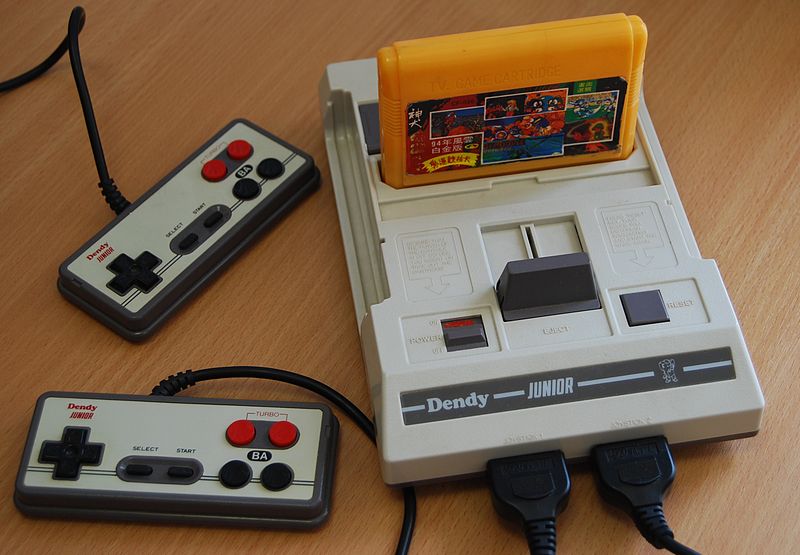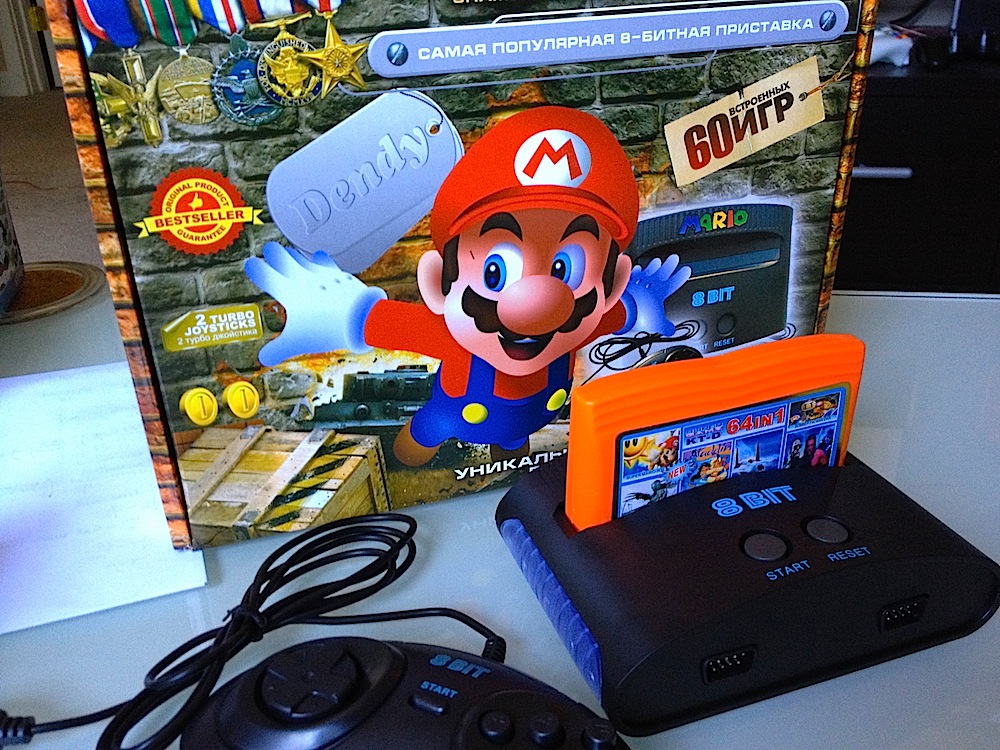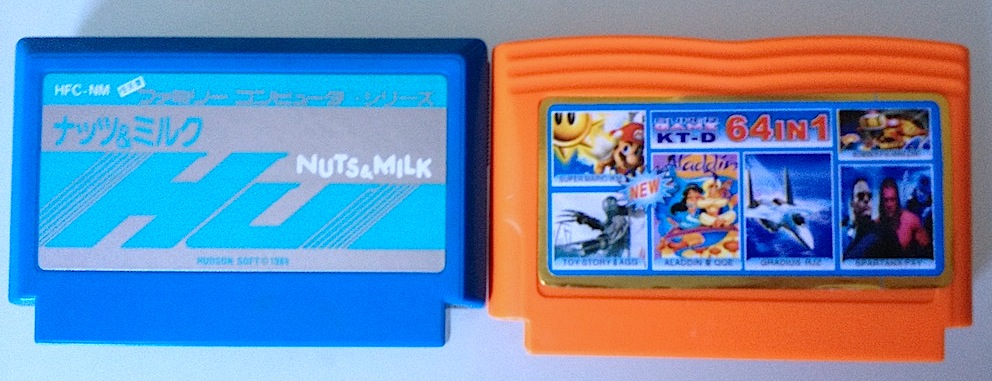Dendy: The Unofficial Official Famicom of Russia
In Soviet Russia, Famicom plays you.
Most avid fans of the Nintendo Entertainment System know a bit about its international lineage. The console released in late 1985 in the United States was first released in Japan in summer 1983. Europe and Oceania had to wait even longer. According to Wikipedia, ‘France, the Netherlands, West Germany, Norway, Denmark and Sweden and saw the NES released during 1986. The console was released in the second region, consisting of the United Kingdom, Republic of Ireland and Italy, as well as Australia and New Zealand, the following year.’ Thanks to the delay and Nintendo’s heinous licensing practices (they controlled manufacturing, censored content, demanded exclusivity, etc.), Europe was largely unimpressed by the aging system, especially compared to inexpensive, open PC platforms like the Sinclair ZX Spectrum, Commodore 64, and so on.
Nintendo had a wide international reach, but they could not serve all markets equally, if at all. And in markets where overwhelming demand is insufficiently satisfied, alternative options emerge. The Famicom hardware, for better and worse, was much easier to circumvent than the NES. Nintendo did not bake in any anti-piracy measures to prevent cartridge reproduction, so pirates did as pirates will do. When Nintendo introduced the Family Computer Disk System (FDS) peripheral, they erected better barriers. They used weird proprietary disks with engraved letters meant to serve as a physical lock-and-key device, as well as some software checks to ensure only authorized disks would play. These measures also failed. Nintendo redoubled their efforts with the NES. A new ‘lockout chip,’ the CIC, was embedded in every cart and console. A special bit of software called 10NES orchestrated a digital handshake between the two that once again ensured only approved NES game paks could play. These ultimately proved to be failures on two fronts: first, the lockout chip could freak out when the carts or console were dirty or bent, a common occurrence thanks to the NES’s weird loading mechanism; and second, pirates and unlicensed developers alike found inventive means to circumvent the CIC.
In countries where the Famicom/NES had no official release, ambitious pirates not only manufactured their own unauthorized cartridges, but copied the entire console. These so-called ‘Famiclones’ were custom-built machines that mimicked the internal functions of the original machine–a kind of emulator in hardware–in order to play games. In many cases, the mimicry surfaced in the external design as well. A Famiclone would often look like a standard Famicom with an alternate palette and branding.
In the Soviet Union, a remarkable thing happened. Since there was no official Nintendo console in the region, an unknown Taiwanese firm partnered with the Russian company Steepler to produce the Dendy, an ‘official’ unofficial console compatible with Famicom games. The Dendy filled a significant void in the Russian market. Game consoles were rare, so the sudden widespread availability of a low-cost machine made it incredibly popular. An entire ecosystem of marketing, including mascots, television shows, and commercials arose around what was technically a black market product.

I am fortunate to have a graduate school friend and colleague, Vera Brown, who is a Russian native. She recalled the console fondly when I asked if she had heard of it. In the same way that the NES was my childhood console, the Dendy was hers.
Unfortunately, information online is still scarce (though improving). The NesDev community has provided some nice technical details about the console, but much is still unknown. Few Dendys have made their way to the US and the myriad versions produced over the years makes a single hardware configuration difficult to pin down. Most of the sources cited on Wikipedia were Russian, so I asked Vera to translate a short article from a Russian newspaper announcing the debut of the Dendy in 1992. The translation follows below (which I lightly edited for clarity):
Steepler starts sales of Dendy
A Moscow-based company is starting a big video game
The firm Steepler was the first of the Russian companies to specialize in television game consoles. Yesterday, the company started to sell game consoles under its own trademark Dendy, which is produced for Steeper by one of the Taiwanese firms. Aside from the console, Steepler will sell interchangeable game cartridges through a dealer chain, along with light pistols and other accessories bearing the Dendy trademark.
The television game console is a miniature computer, which costs significantly less than a usual game computer and is very easy to use. It is connected to a home television and allows, with the help of a few buttons, to play the game recorded inside the interchangeable memory device (the cartridge). In the West, the market of game consoles and game cartridges is very affluent, and the volume of sales of these devices is constantly growing. For instance, according to the data of an American manufacturer of game consoles, the firm Nintendo, their games are played in every third household in the USA, and their gross yearly net worth will be around $6 billion. However, in Russia, game consoles are not well known because of small and irregular shipments. The biggest distribution in Russia belongs to the video games of the Japanese firm Atari. But in the last three years, this company suffered a defeat in competition with American and European manufacturers of similar devices. This year, Atari was not represented in any major convention of video games. Now, the firm is closing its production of game consoles, and new games for Atari are very rarely released.
According to the head of the video game department of Steepler, Viktor Savyuk, the firm invested around $1 million into the video game business. Steepler signed a long-term contract with the Taiwanese firm, whose name remains secret. According to this contract, the Taiwanese firm will produce video games for Steepler according to their own patented technological process. Video games, as well as other accessories and related goods, will be sold in the Russian market under the Dendy trademark, which Steepler specifically registered for this new business. Mr. Savyuk said that Steepler had spent a long time carefully choosing a partner, and the choice was made, aside from the high quality of the product, according to the low prices–from $70-$80 per unit (American consoles cost $100-$300). Furthermore, this Taiwanese firm is one of the few companies that produce video games in the television standard SECAM D/K, prevalent in the territory of the former USSR. Steepler representatives expressed their certainty that they will have plenty of competitors in this new business very soon.
The article gives us a nice glimpse into the Russian perception of videogames in 1992. A large portion of the text has to describe what game console are, how they function, and how popular they are outside of Russia. Atari is incorrectly labeled a ‘Japanese firm’ while Nintendo is American. Both are understandable mistakes: the former derived their name from a Japanese word, while the latter had a separate branch of operations, Nintendo of America. Also note that the Dendy’s link to Nintendo is never divulged, nor is the ‘secret’ Taiwanese firm.
In 1992, the Dendy was a clone of a nearly decade-old console. In technology-years, it was positively ancient, but for a videogame-starved nation, it opened up a whole new world of media. Remarkably, the Dendy is still sold today. I asked Vera to pick one up for me while she was in Russia this past Spring and she brought back this excellent ‘Dendy 8-bit’ and a pirate multi-cart.

I asked her why Mario was flying above a backdrop littered with army regalia. Note the field medals and dog tags on the front of the box, as well as a fleet of tanks blasting out of the brick background. She said the salesman emphasized, with great excitement, that the Dendy included Tank among its 60 built-in games. Vera explained that, along with Super Mario, Tank was a popular favorite from her childhood. I haven’t fired the console up yet, but I’m assuming this is a port of Atari’s Combat, since many Famiclones are used to power the ‘every Atari game in a joystick’ TV games sold in the U.S. Yes, a hardware clone of a Famicom running an Atari emulator. The future is here.
Also note that the Dendy is a bizarre mashup of numerous console generations. While the interior circuitry clones the Famicom, the console’s exterior and six-button controller mimic a late-model Sega Genesis. Meanwhile, the packaging features an unlicensed Mario derived from the Nintendo 64 era hovering above the tanks featured in an Atari 2600 game.

Finally, I’ll point out that the pirate cartridge format is nearly identical to an official Famicom cartridge. It has the same 60-pin cart connector and could presumably play in a standard Famicom (I don’t have mine hooked up at the moment, so I can’t test it out). However, the cart uses a custom mapper to accomodate ’64 games.’ According to the front label, I will be able to play Super Mario IKM, Toy Story II AGG, Aladdin III QQE, Gradius RJZ, Bomber Pacman ZWK, and Spartanx PXY. Oh my!